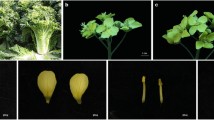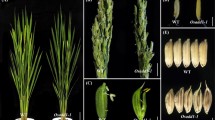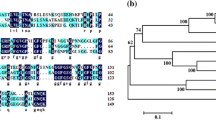Abstract
Ogura cytoplasmic male sterility (OguCMS) is the most important CMS system used for F1 hybrid cabbage production worldwide. The anther abortion and defective pollen development exhibited in OguCMS are coordinately regulated by the mitochondrial male sterile gene orf138 and many nuclear transcriptional regulatory factors. AT-hook DNA binding proteins regulate cell-specific gene expression. In this study, we cloned the gene encoding the AT-hook DNA binding protein BoMF2 using the cDNA-AFLP TDF sequence, which was upregulated in OguCMS cabbage flower buds, as a querying probe. BoMF2 contains a 783-nt continuous complete open reading frame encoding a 260 amino-acid polypeptide. In vivo transient expression assays using GFP fusions showed that BoMF2 protein was located in the nucleus. BoMF2 was preferentially expressed in cabbage stamens, with a short expression window at anther development stage 7–8. However, in OguCMS flowers, BoMF2 expression continued into the mature pollen stage and was concomitant with the continued proliferation of tapetum cells exhibited in this mutant. Arabidopsis plants overexpressing BoMF2 showed significantly shorter siliques than the wild type, as well as decrease of pollen viability. These results suggest that BoMF2, a transcriptional regulatory factor, might regulate tapetum proliferation during anther development.






Similar content being viewed by others
Abbreviations
- BoMF2:
-
Brassica oleracea male fertility 2
- OguCMS:
-
Ogura cytoplasmic male sterility
- qRT-PCR:
-
Quantitative real time RT-PCR
- AHL:
-
AT-hook nuclear localized protein
References
Ogura H (1968) Studies on the new male sterility in Japanese radish with special reference to the utilization of this male sterility towards the practical raising of hybrid seeds. Mem Fac Agric Kagoshima Univ 6:39–78
Bannerot H, Boulidard L, Cauderon Y, Tempe J (1974) Transfer of cytoplasmic male sterility from Raphanus sativus to Brassica oleracea. Proc Eucarpia Meet Cruciferae 25:52–54
Sigareva MA, Earle ED (1997) Direct transfer of a cold-tolerant Ogura male-sterile cytoplasm into cabbage (Brassica oleracea ssp. capitata) via protoplast fusion. Theor Appl Genet 94:213–220
Kao H, Brown G, Scoles G, Seguin-Swartz G (1991) Ogura cytoplasmic male sterility and traizine tolerant Brassica napus cv. Westar produced by protoplast fusion. Plant Sci 75:63–72
Kao HM, Keller WA, Gleddie S, Brown GG (1992) Synthesis of Brassica oleracea/Brassica napus somatic hybrid plants with novel organeile DNA compositions. Theor Appl Genet 83:313–320
Bartkowiak-Broda I, Rousselle P, Renard M (1979) Investigations of two kinds of cytoplasmic male sterility in rapeseed (Brassica napus L.). Genet Pol 20:487–497
Pelletier G, Ferault M, Lancelin D, Boulidard L (1989) CMS Brassica oleracea cybrids and their potential for hybrid seed production. XII Eucarpia Congress, Gottingen (Poster Abstract)
de Melo PE, de Giordano LB (1994) Effect of Ogura male-sterile cytoplasm on the performance of cabbage hybrid variety. II. Commercial characteristics. Euphytica 78:149–154
Delourme R, Budar F (1999) Male sterility. In: Gómez-Campo C (ed) Biology of Brassica coenospecies. Elsevier Science, Amsterdam, pp 185–216
Grelon M, Budar F, Bonhomme S, Pelletier G (1994) Ogura cytoplasmic male-sterility (CMS) associated orf138 is translated into a mitochondrial membrane polypeptide in male-sterile Brassica cybrids. Mol Gen Genet 243:540–547
Gourret JP, Delourme R, Renard M (1992) Expression of ogu cytoplasmic male sterility in cybrids of Brassica napus. Theor Appl Genet 83:549–556
Yang S, Terachi T, Yamagishi H (2008) Inhibition of chalcone synthase expression in anthers of Raphanus sativus with Ogura male sterile cytoplasm. Ann Bot 102:483–489
Bonhomme S, Budar F, Lancelin D, Small I, Defrance MC, Pelletier G (1992) Sequence and transcript analysis of the Nco2.5 Ogura-specific fragment correlated with cytoplasmic male sterility in Brassica cybrids. Mol Gen Genet 235:340–348
Koizuka N, Imai R, Fujimoto H, Hayakawa T, Kimura Y, Kohno-Murase J, Sakai T, Kawasaki S, Imamura J (2003) Genetic characterization of a pentatricopeptide repeat protein gene, orf687, that restores fertility in the cytoplasmic male-sterile Kosena radish. Plant J 34:407–415
Duroc Y, Gaillard C, Hiard S, Defrance M-C, Pelletier G, Budar F (2005) Biochemical and functional characterization of orf138, a mitochondrial protein responsible for Ogura cytoplasmic male sterility in Brassiceae. Biochimie 87:1089–1100
Fujimoto S, Matsunaga S, Yonemura M, Uchiyama S, Azuma T, Fukui K (2004) Identification of a novel plant MAR DNA binding protein localized on chromosomal surfaces. Plant Mol Biol 56:225–239
Aravind L, Landsman D (1998) AT-hook motifs identified in a wide variety of DNA-binding proteins. Nucleic Acids Res 26:4413–4421
Morisawa G, Han-yama A, Moda I, Tamai A, Iwabuchi M, Meshi T (2000) AHM1, a novel type of nuclear matrix-localized, MAR binding protein with a single AT hook and a J domain-homologous region. Plant Cell 12:1903–1916
Lim PO, Kim Y, Breeze E, Koo JC, Woo HR, Ryu JS, Park DH, Beynon J, Tabrett A, Buchanan-Wollaston V, Nam HG (2007) Overexpression of a chromatin architecture controlling AT-hook protein extends leaf longevity and increases the post-harvest storage life of plants. Plant J 52:1140–1153
Street IH, Shah PK, Smith AM, Avery N, Neff MM (2007) The AT-hook containing proteins SOB3/AHL29 and ESC/AHL27 are negative modulators of hypocotyl growth in Arabidopsis. Plant J 54:1–14
Matsushita A, Furumoto T, Ishida S, Takahashi Y (2007) AGF1, an AT-hook protein, is necessary for the negative feedback of AtGA3ox1 encoding GA 3-oxidase. Plant Physiol 143:1152
Vom Endt D, Soares e Silva MS, Kijne JW, Pasquali G, Memelink J (2007) Identification of a bipartite jasmonate-responsive promoter element in the Catharanthus roseus ORCA3 transcription factor gene that interacts specifically with AT-hook DNA-binding proteins. Plant physiol 144:1680–1689
Kang J, Zhang G, Bonnema G, Fang Z, Wang X (2008) Global analysis of gene expression in flower buds of Ms-cd1 Brassica oleracea conferring male sterility by using an Arabidopsis microarray. Plant Mol Biol 66:177–192
Doyle JJ (1987) A rapid DNA isolation procedure for small quantities of fresh leaf tissue. Phytochem Bull 19:11–15
Liu Y, Mitsukawa N, Oosumi T, Whittier RF (1995) Efficient isolation and mapping of Arabidopsis thaliana T-DNA insert junctions by thermal asymmetric interlaced PCR. Plant J 8:457–463
Livak KJ, Schmittgen TD (2001) Analysis of relative gene expression data using real-time quantitative PCR and the 2 CT method. Methods 25:402–408
Tamura K, Dudley J, Nei M, Kumar S (2007) MEGA4: molecular evolutionary genetics analysis (MEGA) software version 4.0. Mol Biol Evol 24:1596
Higo K, Ugawa Y, Iwamoto M, Korenaga T (1999) Plant cis-acting regulatory DNA elements (PLACE) database: 1999. Nucleic Acids Res 27:297–300
Bate N, Twell D (1998) Functional architecture of a late pollen promoter: pollen-specific transcription is developmentally regulated by multiple stage-specific and co-dependent activator elements. Plant Mol Biol 37:859–869
Filichkin SA, Leonard JM, Monteros A, Liu PP, Nonogaki H (2004) A novel endo-betamannanase gene in tomato LeMAN5 is associated with anther and pollen development. Plant Physiol 134:1080–1087
Rogers HJ, Bate N, Combe J, Sullivan J, Sweetman J, Swan C, Lonsdale DM, Twell D (2001) Functional analysis of cis-regulatory elements within the promoter of the tobacco late pollen gene g10. Plant Mol Biol 45:577–585
Abe H, Urao T, Ito T, Seki M, Shinozaki K, Yamaguchi-Shinozaki K (2003) Arabidopsis AtMYC2 (bHLH) and AtMYB2 (MYB) function as transcriptional activators in abscisic acid signaling. Plant Cell 15:63–78
Hartmann U, Sagasser M, Mehrtens F, Stracke R, Weisshaar B (2005) Differential combinatorial interactions of cis-acting elements recognized by R2R3-MYB, BZIP, and BHLH factors control light-responsive and tissue-specific activation of phenylpropanoid biosynthesis genes. Plant Mol Biol 57:155–171
Sanders PM, Bui AQ, Weterings K, McIntire KN, Hsu YC, Lee PY, Truong MT, Beals TP, Goldberg RB (1999) Anther developmental defects in Arabidopsis thaliana male-sterile mutants. Sex Plant Reprod 11:297–322
Ng KH, Yu H, Ito T (2009) AGAMOUS controls GIANT KILLER, a multifunctional chromatin modifier in reproductive organ patterning and differentiation. PLoS Biol 7(11):e1000251
Yadeta KA, Hanemian M, Smit P, Hiemstra JA, Pereira A, Marco Y, Thomma BPHJ (2011) The Arabidopsis thaliana DNA-binding protein AHL19 mediates Verticillium wilt resistance. Mol Plant Microbe Interact 24:1582–1591
Xiao C, Chen F, Yu X, Lin C, Fu YF (2009) Over-expression of an AT-hook gene, AHL22, delays flowering and inhibits the elongation of the hypocotyl in Arabidopsis thaliana. Plant Mol Biol 71:39–50
Pedersen TJ, Arwood LJ, Spiker S, Guiltinan MJ, Thompson WF (1991) High mobility group chromosomal proteins bind to AT-rich tracts flanking plant genes. Plant Mol Biol 16:95–104
Klosterman SJ, Hadwiger LA (2002) Plant HMG proteins bearing the AT-hook motif. Plant Sci 162:855–866
Liu L, White MJ, MacRae TH (1999) Transcription factors and their genes in higher plants. Eur J Biochem 262:247–257
Peiffer JA, Kaushik S, Sakai H, Arteaga-Vazquez M, Sanchez-Leon N, Ghazal H, Vielle-Calzada JP, Meyers BC (2008) A spatial dissection of the Arabidopsis floral transcriptome by MPSS. BMC Plant Biol 8:43
Alves-Ferreira M, Wellmer F, Banhara A, Kumar V, Riechmann JL, Meyerowitz EM (2007) Global expression profiling applied to the analysis of Arabidopsis stamen development. Plant Physiol 145:747–762
Goldberg RB, Beals TP, Sanders PM (1993) Anther development: basic principles and practical applications. Plant Cell 5:1217–1229
Ríos G, Tadeo FR, Leida C (2013) Badenes ML (2013) Prediction of components of the sporopollenin synthesis pathway in peach by genomic and expression analyses. BMC Genomics 14:40
Acknowledgments
This work was supported by Grants from the Natural Science Foundation of China (31372065), the National High Technology R&D Program of China (2012AA100105, 2012AA020103) and the Key Projects in the National Science & Technology Pillar Program during the Twelfth Five-Year Plan Period (2012BAD02B01, 2012BAD50G01).
Author information
Authors and Affiliations
Corresponding author
Rights and permissions
About this article
Cite this article
Kang, J., Guo, Y., Chen, Y. et al. Upregulation of the AT-hook DNA binding gene BoMF2 in OguCMS anthers of Brassica oleracea suggests that it encodes a transcriptional regulatory factor for anther development. Mol Biol Rep 41, 2005–2014 (2014). https://doi.org/10.1007/s11033-014-3048-2
Received:
Accepted:
Published:
Issue Date:
DOI: https://doi.org/10.1007/s11033-014-3048-2




